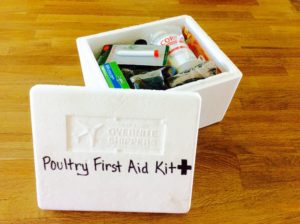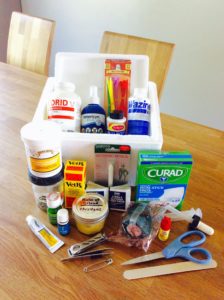By Krislee Johnson
As a novice poultry keeper my first year with the flock was full of new learning experiences, some requiring poultry first aid. While most days I experienced free-range bliss, it was inevitable a bird would be injured or fall sick.
I came up with a great starter kit that helped me care for my chickens, ducks and turkeys. In fact, it even saved the life of a duck named Diller.

POULTRY FIRST AID KIT
- Scissors
- Nail clippers
- Nail file
- Safety pin or needle
- Tweezers
- Measuring dropper or syringe
- Leg bands
- Chicken saddle
- Tape
- Vet wrap
- Gauze pads
- Alcohol swabs
- Super glue
- Styptic pencil
- Balm of Gilead
- Oregano essential oil
- Campho-phenique
- Antibiotic cream
- Dry oregano & cayenne pepper
- Diatomaceous earth
- Vet Rx Poultry
- Rooster Booster, vitamins & electrolytes w/ lacto bacillus
- Corid
- Vetericyn +plus
- Blu-Kote
- Wazine 17
Admittedly, much of my first aid kit has never been used. In true Boy Scout fashion (or in my case Girl Scout), I always try to be prepared. Living in a rural area a quick trip to town isn’t always easy. In some cases, emergency treatment can’t wait the full hour it would take me to secure supplies. So, let me share with you ‘how and why’ I use these items in my Poultry First Aid Kit.

THE TOOLS
Scissors – For cutting tape, clipping feathers.
Nail Clippers – For trimming long toenails which can cause foot issues. Yes, even free-range chicken’s nails get long! The clippers can also be used to trim back beak tips. Slightly misaligned or overgrown beaks can result in eating issues.
Nail File – This tool’s use might seem a bit obvious. Use it to file down sharp nails, spurs or beaks.
Safety Pin or Needle – For use in removing ingrown feathers or teasing out a bumblefoot core.
Tweezers – Helps remove slivers, bumblefoot cores, ingrown feathers etc.
Measuring Dropper / Syringe – These can be used to accurately measure medication dosages or to feed a sick bird.
Leg Bands – In large flocks with similar looking birds this helps identify birds you are keeping an eye on.
Chicken Saddle – This is great for hens that have bare backs due to over zealous roosters or molting. It’s a way to provide the skin protection from further injury.
Tape – Again, the use is somewhat obvious, to secure bandages. It’s also a good way to test for and remove mites.
Vet Wrap – This self-sticking wrap secures gauze and protects injuries from dirt. I use it for birds treated for bumblefoot.
Non-Stick Gauze Pads – To protect an injured area or as part of a dressing for bumblefoot.
Alcohol Swabs – This is a great way to clean an area prior to opening the skin. Ingrown feathers, bumblefoot core removal etc.
Styptic Pencil – For small wounds or if a chicken is bleeding after a toenail clip. This will stop the bleeding and protect the area from dirt etc.
Super Glue – One of the simplest ways to close a wound without having to resort to stitches. I utilized this gem to close a gash in my duck’s neck after being attacked by our dog. Clean the wound, hold together, apply glue. Once set add a nice layer of Blu-Kote. My duck Diller healed well.
MEDICATIONS & TREATMENTS
Diatomaceous Earth – For use in prevention and treatment of mites or external pests. This is a great addition to a dust bathing area. Internally, it can be added to feed to act as a wormer.
Wazine 17 – This is a Turkey, Chicken & Swine treatment for round worms. Follow the directions on the bottle.
Corid – For treatment of coccidiosis. I have the 9.6% oral solution. Dose at 1.5 tsp per gallon of water, change daily for 5-7 days. Consult a vet to be sure this will work for you. Coccidiosis can spread fast and be devastating to your flock.
Vetericyn +plus – Great treatment for cuts, abrasions, sores and skin irritations that are in areas difficult to bandage. It contains no alcohol, steroids or antibiotics.
Vet Rx Poultry – 100% natural water additive to support upper respiratory function. I put this in my bird’s water during the winter. It can also help with dryness on their comb, wattles, legs, feet and their beaks.
Blu-Kote – This is a great protective wound antiseptic. It is also germicidal and fungicidal. It stains so be sure to use some rubber gloves when applying.
Campho-Phenique – I use this to aid in the comfort of my birds during bumblefoot removal. They typically don’t overreact to pain stimuli but this can help numb the area temporarily.
Oregano Essential Oil – I add this to my bird water all winter long. It helps support the immune health of the bird.
Dry Oregano & Cayenne Pepper – Supports overall health without the use of antibiotics, the latter stimulates egg laying production.
Antibiotic Cream – In most cases I stay away from antibiotic treatments but I use this as my last resort for a bumblefoot area that feels hot and pink.
Balm of Gilead – I make this natural “antibiotic” balm using coconut oil, bee’s wax and sticky spring cottonwood buds. It is also a natural analgesic.
Rooster Booster Vitamins & Electrolytes w/ Lacto Bacillus – For sick chickens or in hot weather it’s nice to give the birds a boost. The powder formula is easy to store and mix. Birds have been known to become severely dehydrated because of simple things such as water temperature – they don’t like warm water.
IN SUMMARY
There are plenty more products out there meant for specific use with poultry. I found that much of it may not be needed or perhaps there was something else that worked best for my particular situation. I am certain over the next year there will be changes or additions to my Poultry First Aid Kit. As my experience grows, new injuries and illnesses will indeed crop up.
Keeping your birds healthy is one way to secure your investment and ensure a future filled with feathery enjoyment. In the end, it pays to be prepared with the basics.













4 Comments
The plus in 3AB is lidocaine, which should not be used on chickens.
Good thing for a novice to know! Hopefully others will learn all these tidbits along with me!
I would be careful with the antibiotic cream with pain relief. Anything with ‘caine’ at the end of it is actually harmful to chickens. I also would caution about using Wazine, Corid, etc. I don’t believe that grabbing a chemical medication should ever be the first reaction, especially without a qualified vet diagnosis.
Lisa
Fresh Eggs Daily
I agree with not always running to grab a chemical treatment. Many things can be treated naturally. Sometimes, you just have to be prepared hence the reason my kit contains all sorts of things I have yet to use. Thanks for the information on the pain relief including ‘caine’, very good information for a novice poultry keeper such as myself to know! Plenty of good advice from seasoned veterans can be priceless!